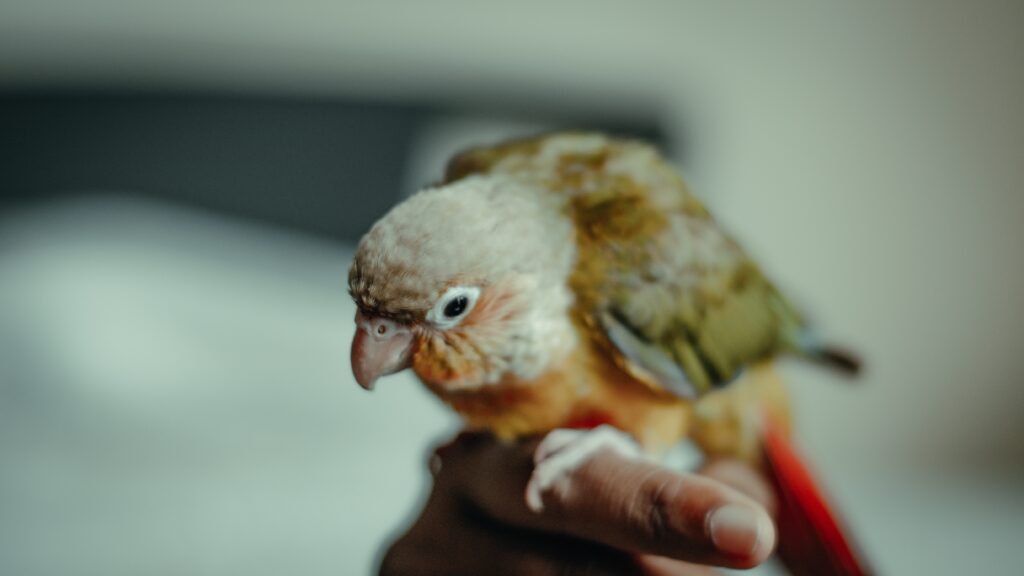To train your parrot to talk, start by creating a consistent training routine and using positive reinforcement, such as treats and praise, when they make an effort to vocalize. Speak clearly and repetitively to your parrot to reinforce specific words or phrases, and be patient as it may take time for them to mimic sounds.
Training your parrot to talk step by step is a gradual process that requires consistency and positive reinforcement to encourage vocalization. With patience and dedication, you can successfully train your parrot to talk and engage in meaningful communication with you.
Parrots are known for their ability to mimic human speech, and many owners are eager to teach their feathered friends to talk. Training a parrot to talk can be a rewarding experience, but it requires patience, consistency, and positive reinforcement. In this guide, we will explore the step-by-step process of training your parrot to talk, providing valuable tips and techniques to help you effectively communicate with your feathered companion.

Credit: www.nytimes.com
Why Train Your Parrot To Talk
Training your parrot to talk can be a rewarding and entertaining experience for both you and your feathered friend. Many people are drawn to the idea of having a parrot that can communicate with them, and teaching your parrot to talk can enhance your bond with them and provide mental stimulation. In this article, we will explore the benefits of teaching your parrot to talk, the bonding experience it creates, and the enhanced mental stimulation it offers.
Benefits Of Teaching Your Parrot To Talk
Teaching your parrot to talk offers numerous benefits that can enhance your relationship and provide mental stimulation for your feathered companion. Let’s explore some of these benefits:
The Bonding Experience
Learning to communicate with your parrot creates a strong bond between the two of you. It fosters a sense of connection and understanding, deepening your relationship and mutual trust.
Enhanced Mental Stimulation
Teaching your parrot to talk stimulates their cognitive abilities, keeping their mind active and engaged. This can prevent boredom and its associated behavioral issues, leading to a happier, more fulfilled pet.

Credit: www.youtube.com
Getting Started With Parrot Training
Choosing The Right Parrot Species
When choosing a parrot species for talking, consider african grey parrots as they are known for excellent talking abilities. Amazon parrots and budgerigars are also good choices for talkative pets.
Creating The Ideal Learning Environment
Place your parrot’s cage in a quiet area without a lot of distractions. Provide mental stimulation with toys and puzzles to keep your parrot’s mind active.
Establishing Trust With Your Parrot
Speak softly to your parrot and offer treats to gain its trust. Spend time daily sitting near the cage to help build a bond with your parrot.
Basic Training Techniques
Training your parrot to talk can be a rewarding and fun experience. Basic training techniques help establish a foundation for teaching your parrot words and phrases. By using positive reinforcement, repetition, and consistency, you can guide your parrot towards becoming a talkative companion.
Teaching Your Parrot Words And Phrases
Teaching your parrot words and phrases is an essential step in training your parrot to talk. Start with simple, easy-to-pronounce words and repeat them regularly in a clear and consistent manner. Use short words like “hello” or “goodbye” to begin with and gradually introduce longer phrases.
Using Positive Reinforcement
Positive reinforcement is a powerful tool when training your parrot. Whenever your parrot utters a word or phrase, praise and reward them with their favorite treat or a gentle pat on the head. This positive response helps your parrot associate talking with positive experiences, encouraging them to continue their efforts.
Repetition And Consistency
Repetition and consistency are key factors in training your parrot to talk. Set aside regular training sessions, preferably at the same time each day, to work on vocabulary. During these sessions, consistently repeat the chosen words or phrases, ensuring your parrot has ample opportunity to hear and learn them.
Remember to be patient and persistent. It may take time for your parrot to grasp the words and phrases, but with repetition and consistency, they will eventually start to mimic and understand them.
Incorporating Play And Interaction
Training your parrot to talk should be a fun and interactive experience for both of you. Incorporate playtime and interaction during the training sessions. Encourage your parrot to repeat words during play and respond positively when they make an effort. This playful approach strengthens the bond between you and your parrot while reinforcing their learning.
Make sure to create a distraction-free environment during training sessions. Minimize background noises and provide a comfortable and calm space for your parrot to focus on learning.
Patience And Perseverance
Patience and perseverance are essential when training your parrot to talk. Each parrot learns at their own pace, so it’s important to stay consistent, positive, and patient throughout the process. Celebrate small milestones, and don’t get discouraged if progress seems slow. Remember, with time and consistent effort, your parrot will develop an impressive vocabulary!

Credit: birdsupplies.com
Advanced Training Methods
Advanced training methods can take your parrot’s talking skills to the next level. By incorporating techniques such as teaching your parrot to speak in context, introducing vocalization cues, and building a vocabulary, you can unlock the full potential of your parrot’s communication abilities. Let’s explore each of these methods in detail.
Teaching Your Parrot To Speak In Context
To truly enhance your parrot’s talking skills, it’s important to teach them how to speak in context. This means encouraging them to use specific words or phrases in appropriate situations. Here’s how you can achieve this:
- Identify common situations: Observe your parrot’s behavior and identify everyday situations where they can use specific words or phrases. For example, when it’s time to eat, you can teach them to say “hungry” or “dinner time.”
- Consistency is key: Consistently repeat the desired words or phrases in the appropriate contexts. This will help your parrot understand the connection between the situation and the words they need to say.
- Reinforcement: When your parrot successfully speaks in context, provide positive reinforcement such as treats or praise. This will encourage them to continue using the correct words in the right situations.
- Patience and repetition: Remember, training takes time and repetition. Be patient and continue to reinforce the desired behavior until your parrot fully understands how to speak in context.
Introducing Vocalization Cues
Vocalization cues are verbal or physical prompts that help your parrot understand when to speak certain words or phrases. By introducing vocalization cues, you can further refine your parrot’s communication skills. Here’s how to do it:
- Select specific cues: Choose simple and distinct vocalization cues that correspond to the words or phrases you want your parrot to speak. This can be a short whistle, a specific word, or a unique sound.
- Associate cues with desired behavior: Pair the vocalization cues with the desired behavior. For example, when you say the cue “talk,” your parrot knows it’s time to speak.
- Repetition and reinforcement: Repeat the cues consistently and reinforce the behavior with rewards whenever your parrot correctly responds to the cues. This will help them associate the cues with the desired action.
Building A Vocabulary
Building an extensive vocabulary is essential for your parrot to become a proficient talker. Here’s how you can expand their word bank:
- Start with basic words: Begin with simple words that are easy for your parrot to mimic, such as their name or simple phrases like “hello” and “goodbye.”
- Progress to more complex words: Gradually introduce more complex words or phrases that you want your parrot to learn. Repeat these words consistently and reinforce them when your parrot successfully imitates them.
- Expand the vocabulary: Continuously expose your parrot to new words and phrases. Use repetition, positive reinforcement, and patience to help them acquire and retain new vocabulary.
- Encourage natural conversations: Once your parrot has a solid vocabulary foundation, encourage them to engage in natural conversations by responding to specific prompts or interacting with you.
By utilizing these advanced training methods, you can take your parrot’s talking abilities to greater heights. Remember, consistency, patience, and positive reinforcement are key to successful training. Start implementing these techniques today, and watch your parrot become a skilled and engaging communicator.
Overcoming Challenges
Learn how to train your parrot to talk step by step, overcoming challenges along the way. Discover effective techniques and tips for successful parrot communication.
Dealing With Shyness Or Fear
If your parrot is shy or exhibits signs of fear, it’s important to approach the training process with patience and understanding. Remember, every parrot is unique, and some may require a little more time to gain trust and overcome their shyness. Here are some steps you can take to help your parrot feel more comfortable:
- Start with a safe space: Create a calm and secure environment for your parrot to feel at ease. Provide a quiet room or an area away from distractions where you can begin the training process.
- Offer positive reinforcement: Use treats or favorite toys to reward your parrot for any attempts at vocalization. By associating speaking with positive experiences, your parrot will gradually gain confidence.
- Gradually introduce new sounds: Begin by playing recordings of simple words or phrases to familiarize your parrot with human speech. Start at a low volume and gradually increase it as your parrot becomes more comfortable.
- Be consistent: Set aside dedicated training sessions each day to work with your parrot. Consistency is key to helping your parrot overcome shyness and fear.
Addressing Attention-seeking Behaviors
Parrots are highly social creatures and thrive on attention. However, if your parrot becomes excessively demanding or exhibits attention-seeking behaviors during training, it’s important to address this issue. Here are some strategies you can use:
- Establish a routine: Set a consistent schedule for training sessions, ensuring that your parrot knows when to expect attention. This will help minimize attention-seeking behavior outside of those dedicated times.
- Use your parrot’s energy: Engage your parrot in physical activities to help release excess energy. Provide toys and rotating activities to keep your parrot mentally stimulated.
- Redirect behavior: Whenever your parrot displays attention-seeking behaviors, redirect their focus to a new and constructive task. For example, provide a puzzle toy or engage in a brief training exercise.
- Ignore unwanted behavior: If your parrot starts engaging in attention-seeking behavior, avoid giving it attention. Instead, wait for a calm moment to reward positive behavior.
Troubleshooting Common Training Issues
During the training process, you may encounter some common issues that can hinder progress. Here’s how to troubleshoot and overcome these challenges:
- Inconsistent vocalization: If your parrot is only vocalizing sporadically or inconsistently, revisit the basics of positive reinforcement. Increase the frequency of rewards and ensure a consistent training schedule to reinforce vocalization.
- Lack of interest or motivation: If your parrot seems disinterested or unmotivated during training, try introducing new and exciting stimuli, such as different toys or treats. Finding what motivates your parrot is essential to keep them engaged.
- Regression: It’s not uncommon for parrots to regress in their training progress. If this happens, be patient and return to previously mastered steps. Gradually reintroduce new exercises once your parrot is back on track.
- Distractions: If your parrot gets easily distracted during training, find a quieter and less stimulating environment. Minimize background noise and remove any visual distractions to help your parrot focus.
Frequently Asked Questions On How To Train Your Parrot To Talk Step By Step
How Do You Teach A Parrot To Talk For Beginners?
To teach a parrot to talk, start with simple words and phrases, repeat them frequently, and reward the parrot for mimicking. Use a quiet environment and positive reinforcement to encourage vocalization. Patience and consistent practice are essential. Gradually introduce new words and maintain a consistent training schedule.
How Do You Say Hello In Parrot Language?
You can say “hello” to a parrot by using common greeting words or phrases.
What Is The Easiest Parrot To Train To Talk?
The easiest parrot to train to talk is the African Grey parrot. They have exceptional intelligence and can mimic words and phrases effectively.
Can All Parrots Be Trained To Talk?
Yes, not all parrots can be trained to talk. Training ability varies among individual parrots, as some may be more inclined to learn and mimic human speech than others.
Conclusion
In a nutshell, training your parrot to talk is a rewarding and amusing experience that requires patience and consistency. By following the step-by-step techniques discussed in this blog post, you can effectively teach your feathered friend to mimic words and phrases.
Remember to create a positive and stimulating environment, use repetition, and reward their efforts. With time and practice, your parrot will become a chatty companion that brings joy to your everyday life. Happy training!





